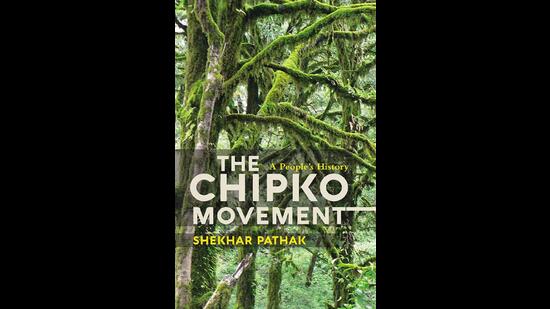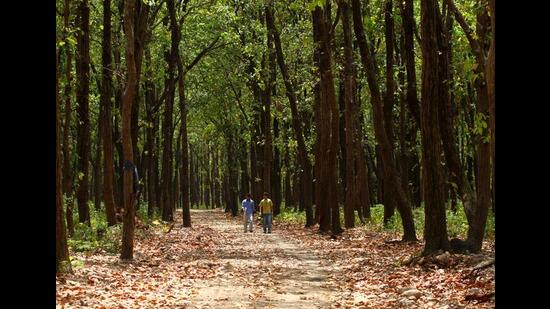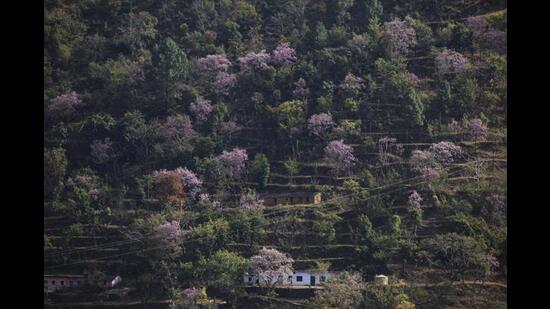Shekhar Pathak, author, The Chipko Movement: ‘Ecology and economy are connected’
The winner of the Kamaladevi Chattopadhyay NIF Book Prize 2022 and founder of the People’s Association for Himalaya Area Research (PAHAR) talks about writing a people’s history of the movement
What made you write Hari Bhari Ummeed (2019) (translated by Manisha Chaudhry into English as The Chipko Movement), published by Vani Prakashan and the Indian Institute of Advanced Studies? Who were the readers you had in mind?

As a participant in the Chipko movement and an inhabitant of the Chipko region, I felt that what I had been reading in some books and magazines was very different from what really happened or was happening. As a student of Himalayan history, I had been researching the social-political movements of Uttarakhand and had realised that there is a continuity of these movements since the beginning of the 20th century. To correct such potential oversights, I felt I had to withdraw as an activist. Initially, I was trying to cultivate the creative objectivity needed to write about such movements. There were time constraints too. My book Uttarakhand Mein Kuli Begaar Pratha (1987) gave me an initial training.
As readers, I had ordinary people and the youth in mind. They are victims of incorrect regional and national histories. I was keen to present the participatory collectiveness and coordination of the movement in different valleys and villages of the region. In this sense, the book is also for folk heroes of the movement/s, all grassroots participants and ordinary villagers, who always played an extraordinary role but remained nameless and faceless in such a contemporary history. You can count more than 200 names and perhaps more than 150 different faces in my book. Some of them were surprised to see their photographs in the book.
How has your work with the People’s Association for Himalaya Area Research (PAHAR) shaped the arguments you make in this book? Which other collectives and organizations have contributed to your understanding of the Chipko Movement?
PAHAR is a pan-Himalayan dream and I am too small to tackle it all by myself. The major idea that I got from PAHAR was to go for diverse, disparate pieces of evidence and sources for writing history and understanding society and its movements. PAHAR’s study tours taught me to understand truth by looking at it from different perspectives and angles. I undertook “multiple interviewing” of the Chipko participants as they had different expressions at different times, not about the basics but about themselves and the level of their fluctuating participation in events when they looked back and reflected. They told me that what they read in books later was not the truth, and what actually happened was not told in such narratives.

While many scholars and participants have been selective in looking at the evolution of the movement, for me it was necessary to look at the whole movement as social mobilisation covering much of 20th century Uttarakhand. For activists and participants, it was but natural to speak and write about their stream but it is not fair for scholars to present selective writing on multi-stream movements. Many organisations associate themselves with Chipko but it belongs only to the people. Even the individual leaders were just leaders of that stream of Chipko rather than their organisations in the context of the movement. But certain organisations and individuals played a crucial role.
The individuals, groups and organisations in Chamoli, Almora, Tehri and Uttarkashi were the first storehouses of memories, experiences and actions. Later, in Uttarakhand itself, Dasholi Gram Swarajya Mandal, Uttarakhand Sangharsh Vahini, Beej Bachao, Pani Rakho, Himalayan Action Research Centre, Himalaya Bachao, Chetna Andolan, Nadi Bachao, Laxmi Ashram, Van Panchayat Sangharsh Morcha, many Mahila Mangal Dals, Van Panchayats and even individuals have done remarkable work. Some Chipko groups, activists and associates of Uttarakhand Sangharsh Vahini tilted to party/electoral politics. But they all have common roots in Chipko. Many associates started some positive work around them. I myself saw the movement becoming part of the past but always vibrating in the present.
So many people from India and abroad tried to understand, support and replicate the ideas of the movement in their own way, though replication is not always possible. Many young people inspired by Chipko did new social-environmental work in Himachal, Karnataka, Delhi, Rajasthan and elsewhere. Thousands of people were inspired by Chipko differently all over the world and started some positive work. Their ideas changed and Chipko lit sparks in their minds.
One of the points you make in the book is that the leadership and ideology of the Chipko Andolan in Uttarakhand was “diverse”; it was “never a singular Gandhian movement”. Why has it been portrayed as a Gandhian movement for so many years?
Chipko was diverse in many ways. The contradictions of post-Independence discourse on natural resources – which more or less followed the colonial legacy of state forestry – gave birth to different social movements questioning the use, management and ownership of these resources. The Indian state failed in evolving policies and laws for such natural resources or “commons” at the very beginning of the Indian republic, so people started agitating. Due to this collective compulsion, after independence, the Kumaon Forest Grievances Committee headed by Baldev Singh Arya was constituted by the UP government in 1959. GB Pant, a leader of begaar abolition and jangalat movements and author of the book The Forest Problem in Kumaon (1922), could not tackle this issue as Premier of United Provinces and later as Chief Minister of Uttar Pradesh. It needed a national debate and consensus, which could not happen. Most of the post-Independence leaders did not even have time to look back at Gandhi and his writings.
People waited and the government used 1962, 1965 and 1971 wars to postpone the issue. Finally, with all reasons already existing, the 1970 Alaknanda flood compelled society to protest. In Chamoli, from where the first expressions of Chipko emerged, the movement was coordinated by Sarvodaya workers but they had the ability to make it an all-party protest and the Communist Party of India was an active participant. Later, the communist workers in Uttarkashi and Tehri, the socialists in Almora, many Congress workers and left-leaning students not only participated in the movement, but also gave it a certain aggressiveness.
On the other hand, the women and students contributed in their own ways. They all made the movement very participatory and non-violent. This feature made it a people’s movement with Gandhian and radical ideas together. Gandhi’s overall shadow was there but it was not just a one-dimensional Sarvodaya movement. One can see differing shades of Sarvodaya ideology here. All the movements of Uttarakhand had the participatory power of people and non-violence as its basic strength. Apart from women and college students, the part played by children should not be forgotten.
Scholars including Anupam Mishra, Anil Agrawal, Ramachandra Guha and many others tried to cover different streams but they did not have time for details. It was Gandhian in the broader context with its different streams. It is also to be noted that more than 100 years back, the people of Uttarakhand developed non-violent but participatory ways of protest. Begaar, jangalat and dola palki were the major movements. When Gandhi came to Kumaon in 1929 and visited Bageshwar – where begaar and jangalat movements were successful – and met hundreds of participants, he termed these movements as “bloodless revolution”.
Who were some of the communists and socialists participating in this movement? How did they react to it being presented and viewed as “spiritual” and “non-violent”?
Kamlaram Nautiyal, Govind Singh Rawat, Chandan Singh Rana, Vidya Sagar Nautiyal, Govind Singh Negi were some of the communist workers/elected representatives. Shamsher Singh Bisht, Pradeep Tamta, PCTiwari, Jagat Rautela, and Sacchidanand Bharati were some of the student leaders with multiple ideological influences. Jaswant Singh Bisht and Bipin Tripathi were socialist workers/elected representatives. These are some of the important names that come to mind. They knew the economic and ecological aspects of the region and the movements. They were also aware of the spiritual aspects related with their culture.
As far as non-violence is concerned, it was always associated with the participatory abilities of the villagers. Kunwar Prasun and Pratap Shikhar both were very much influenced by Jayaprakash Narayan (JP) and they were members of Chhatra Yuva Sangharsh Vahini. Chandi Prasad Bhatt, when he started out as a social activist, was deeply influenced by JP. The impact of PC Joshi, JP and Manohar Lohia on communist and socialist workers was but natural. The influence of Sarala Behn (Catherine Mary Heilman) and Mira Behn (Madeleine Slade) was also there. Through Chandi Prasad, Kedar Singh, Murarilal, Sunderlal and Vimla Bahuguna, Radha Behn, Dhoom Singh and many others, the Gandhian diversity evolved. Ramesh Pahari, Rajiv Lochan Sah, Shailani, Girda and Jeevanand Shriyal joined as journalists and cultural activists. Shyama Devi, Gaura Devi, Sudesha, Bachni, Saupa, Jhabri, Kunti, Kanti, Gayatri, Jeewanti, Kalawati and others played a crucial role as women leaders.

What can environmental activists in today’s India learn from the Chipko movement?
The very first clarity it gives is that ecology and economy are closely connected. Only participatory movements can be sustained. It teaches us that 100 percent successes are impossible in any movement. It also gives us an idea of how to evolve the ability to protest, and how to organise each section of society. Chipko taught us to study, analyse and develop a basic understanding among people about their surroundings, resources, their use and abuse, and the way to save them. The question of traditional forest rights is also there. How forest and pasture land support the little agriculture, cottage industries and daily life in the mountains is important to understand. The oxygen, soil, water, folk gods and folk songs are all closely connected with forests. Forests are at the very centre of mountain life.
Chipko gives the idea that in each village we need an enlightened team, aware of resources, calamities and the changing face of global climate. This was the dream of Chipko activists in their environmental camps and foot marches. It teaches us about uniting ourselves for our resources, justice, equality, local self-government and a decentralised way of governance. Chipko gave us the idea that there is but one Himalaya and it is more than a subcontinental presence. Many times, there were failures too. The forest problem is not yet solved.
What is your assessment of the National Forest Policy of India as it stands today? What changes can be made to ensure that forests are not encroached by capitalist interests?
The 1927 Forest Act is still there. We cannot forget the Forest Conservation Act of 1980 and Forest Rights Act of 2006. These are big turning points in forest legislation and few other acts related to pollution, conservation, wildlife, and biodiversity etc. However, the Indian state is not yet ready to consider the idea of “community ownership of resources”. The state is and should be a democratic custodian, law maker, and implementer for evolving policies and laws as per the changes required but a deep discussion with communities and experts is vital. Corporate loot cannot be part of this scheme. Actually, now with the forest policies and laws, addressing the question of rights of tribal communities, nomads and agriculturists, involving the corporate sector in a very controlled way, and also looking at climatic changes and urbanization are the big challenges. Controlling the carbon footprint is one challenge, saving the remaining wilderness in all eco regions and evolving a “need, not greed” based way of life is another. I must also say that the political economies, which cannot sustain them, should not prescribe the idea of sustainable development to communities.

How do you feel about having your book longlisted for the Kamaladevi Chattopadhyay NIF Book Prize 2022? If you win the prize, how would you use the amount of 15 lakhs? (This interview was conducted before the prize winner was announced)
No one dislikes awards and prizes but, at heart, I do not love them much. If my book is awarded, the prize money will be given for the Himalayan cause only.
What projects are you currently working on? Which ones are you most excited about?
I am finalizing some of my Himalayan travel books and work done at the Nehru Memorial Museum and Library (NMML) on the “idea of opening of the Himalaya”. I am also working on detailed biographies of Pundit Nain Singh Rawat and his great cousin Kishan Singh. The material and memoirs regarding Askot-Arakot Abhiyans are gazing at me as big mountains.
Chintan Girish Modi is a freelance writer, journalist and book reviewer.
Continue reading with HT Premium Subscription




